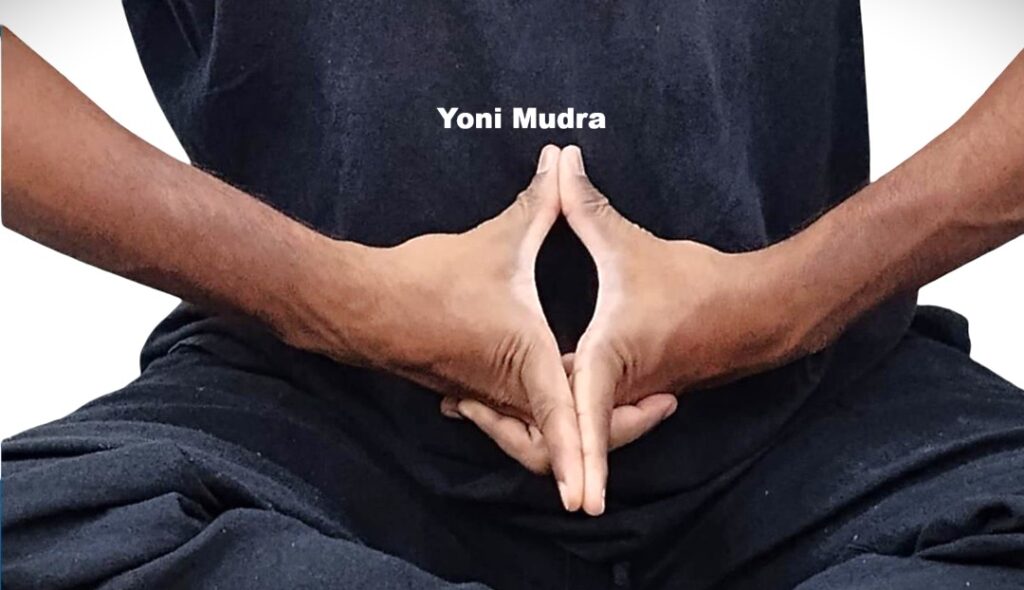Yoni Mudra
Introduction
Yoni Mudra is a meditative hand gesture used in yoga to direct awareness inward, promoting mental clarity, emotional stability, and spiritual awakening. It is often used during pranayama, meditation, and energy work to enhance concentration, calm the mind, and awaken intuitive faculties.
The term comes from Sanskrit:
Yoni: Womb or source of creation; represents origin, inner focus, and purity
Mudra: Seal or gesture to direct prana
Overall Purpose:
Yoni Mudra helps practitioners withdraw from external distractions, focus inwardly, and cultivate mental and emotional equilibrium.
Meaning
Yoni: Symbolic of the source, inner self, and spiritual receptivity.
Mudra: Hand gesture influencing energy and consciousness.
Overall Meaning:
Yoni Mudra symbolizes return to the inner self, promoting introspection, purification of mind, and spiritual focus.
How to Perform / Practice
Sit comfortably in a meditative posture (Padmasana, Sukhasana, or Vajrasana) with a straight spine.
Bring the hands in front of the chest.
Interlock fingers so that the index fingers point downward and touch each other, forming a triangle pointing toward the floor.
Place the thumbs gently together, forming a small triangle pointing upward.
Close your eyes and take slow, deep breaths, directing attention inward toward the navel or heart center.
Practice for 10–15 minutes, gradually increasing to 20–30 minutes.
Focus on breath, inner awareness, and mental calmness throughout the practice.
Tip: Best practiced in a quiet environment to enhance concentration and introspection.
Benefits
Physical Benefits:
Slightly stimulates digestion and abdominal organs.
Improves blood circulation to the hands and fingers.
Promotes relaxation of the body during meditation.
Mental & Emotional Benefits:
Enhances mental clarity, focus, and concentration.
Reduces stress, anxiety, and mental agitation.
Encourages emotional stability and inner peace.
Energetic / Spiritual Benefits:
Activates prana flow toward the inner self.
Supports meditative absorption and spiritual awakening.
Helps purify mind and awaken intuition.
Contraindications
Avoid if experiencing hand or finger injuries.
Not recommended for severe arthritis or joint pain.
Discontinue if numbness, tingling, or discomfort occurs.
Practice moderately if you feel dizziness or excessive inward focus.
Anatomy & Physiology
Muscles: Engages intrinsic hand muscles (lumbricals, interossei) to maintain finger interlocking.
Joints: Flexion at fingers and slight thumb extension.
Nervous System: Activates parasympathetic pathways, promoting calmness and introspection.
Circulation: Enhances peripheral blood flow and supports pranic energy distribution.
Kinesiology
Enhances fine motor control in fingers.
Supports postural stability during seated meditation.
Encourages relaxed hand posture, aiding concentration and energy flow.
Neurology
Stimulates brain regions associated with attention, introspection, and emotional regulation.
Balances autonomic nervous system, reducing sympathetic overactivity.
Supports neural pathways for meditation, focus, and inner awareness.
Duration of Practice
Daily Practice: 10–20 minutes for meditation and introspection.
Short Practice: 5 minutes for mental clarity or relaxation.
Can be combined with pranayama or other meditative mudras for enhanced benefits.
Counter Mudra
Relax hands in Gyan Mudra or place hands on knees with palms upward.
Gentle hand stretches or shaking helps release tension after prolonged practice.
Conclusion
Yoni Mudra is a powerful tool for meditation, inner focus, and spiritual awakening. Regular practice enhances mental clarity, emotional balance, and intuitive awareness while promoting calmness and energy purification, making it ideal for meditation, pranayama, and spiritual development.
FAQ
Q1: Can beginners practice Yoni Mudra?
A: Yes, it is simple and safe; start with a few minutes and gradually increase.
Q2: Can it help with mental clarity and emotional balance?
A: Yes, it reduces stress, enhances focus, and stabilizes emotions.
Q3: Can it be combined with other mudras?
A: Yes, it pairs well with Chin Mudra, Dhyana Mudra, or Vishuddha Mudra.
Q4: Is it suitable for meditation and pranayama?
A: Yes, it deepens concentration and energy flow during meditative practices.
References
Swami Satyananda Saraswati, Mudras for Healing and Transformation.
Iyengar, B.K.S., Light on Yoga.
Saraswati, S., Pranayama and Mudras in Yoga Therapy.
Fishman, L., Yoga for Emotional Balance.
Lad, V., Ayurveda: The Science of Self-Healing.
Journal of Bodywork and Movement Therapies, 2018; 22(4): Effects of Mudras on Mental and Physiological Functions.

